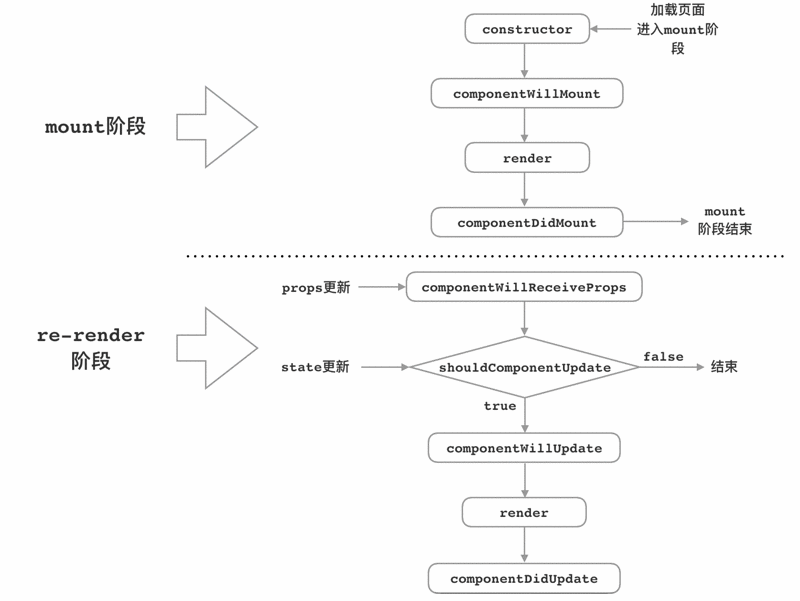浅析 React 生命周期
Overview
最近常有学习React相关的技术,写了几个React的小Demo,使用 React/Express 技术栈。实在太小,羞于拿出来细说。React 的确是一个值得追随的技术。但React体系实在庞大,我目前仅略知一二。这里要挑出来说的,是React的 生命周期 机制。Demo的学习过程中,对它的方便、易用之处实在是深有体会,在一些细节处也值得斟酌,在这里做一下记录,便于分享。
如果你接触过React,大概对 render 和 componentWillMount 等,会相对的熟悉,因为它们再常用不过。但用归用,其中的一些理论上的细节,往往容易在使用的过程中被忽略,使我们多敲了不少代码,心很累的 : )
通俗来讲,React 将组件 component 在web中的形成、修改和渲染等划分为若干个阶段,组成组件的生命周期。在一个完整的生命周期内,一个组件会经过若干个阶段,在特殊的阶段组件会调用一个特别的 lifecycle method ,即生命周期方法。如下:
-
constructor(props)
-
componentWillMount()
-
render()
-
componentDidMount()
-
componentWillReceiveProps(nextProps)
-
shouldComponentUpdate(nextProps, nextState)
-
componentWillUpdate(nextProps, nextState)
-
render( )* //理解上与3. render()略有不同,见下。
-
componentDidUpdate(prevProps, prevState )
-
componentWillUnmount( )
值得注意,这些生命周期是React 内置的,在特定条件下就会被调用。而开发者可以做的就是 override (重载)这些方法,以实现想要的功能。
constructor
constructor(props) ,组件形成时调用。
constructor 函数可理解为组件的构造函数,从组件的类(class) 实例化一个组件实例。这个函数在组件形成时被调用,是所有生命周期函数中 最先执行 的。在constructor函数内,如有必要,进行state的初始化以及绑定方法;否则可以省去constructor函数的声明。
有以下几点在开发时值得注意:
-
constructor 函数内,在执行任何statement之前,必须是super() 函数,如果有参数须将参数带上。这点跟Java很像。
-
在constructor 函数内,
this.props返回undefined -
不要在初试化state时引用props 里的值,否则每当props更新时,都需要在componentWillReceiveProps 函数内对state进行更新。(同时这也涉及到组件state选取的原则,如有需要请阅读 Thinking in React )
class App extends Component {
constructor(props) {
super(props);//------------(1)
console.log(this.props);// undefined ------------(2)
//initialize the state
this.state = {
value: '',
color: props.initialColor // 不可取 ------------(3)
}
//bind methods
this.handleClick = this.handleClick.bind(this);
}
}
componentWillMount
componentWillMount() ,在组件首次渲染( render )之前调用。
mount 有 安装 之意,我们可以理解为 组件首次被加载在web中 。因此每次页面加载/刷新,或者某个组件第一次加载进入web时可以调用componentWillMount( ) 函数。举个例子,在首次进入文章列表时时,可在 componentWillMount 对所有文章进行查询。这样,在render之前,就能拿到所有文章的数据,以便在render中使用。
在componentWillMount ( ) 函数内,若对 this.state 进行更新,无法触发重新渲染组件。
class PostList extends Component {
//...
//在componentWillMount 组件内获取所有博客列表
componentWillMount(){
axios.get('/posts')
.then(res=>{
//...
});
}
//在 render 函数内将拿到的博客列表 渲染在页面中
render(){
//...
}
}
Render
render()
render 即 渲染函数,是编写组件代码时,唯一一个 必须 的函数。该函数须有返回值,返回一个组件,即最终渲染出来的组件。在使用组件的class进行组件实例化时,得到的便是其返回值。
返回值有两种类型:
-
一个父标签,这个父标签内可以包含若干个子标签,在最外层标签必须只有一个。
-
false或者null,代表不渲染任何DOM
class App extends Component {
//...
render(){
return (
<div>
//...
</div>
)
}
}
注意: 在render函数中只做与返回组件相关的工作,勿在其中对 state 进行操作,可以保证每次调用render函数,返回的组件都是相同的。否则将加大项目维护成本。
另外,如果 shouldComponentUpdate 函数返回 false ,则不执行render函数。关于shouldComponentUpdate将在下面介绍。
componentDidMount
componentDidMount() ,一旦组件首次加载完成,便会调用
如果需要对渲染出来的DOM节点做任何操作,可以在此处进行。( 提示 : this.refs 可获取真实DOM)。
在该组件内设置state将会导致组件被重新渲染。
class App extends Component {
//..
componentDidMount(){
//将会触发组件重新渲染
this.setState({
value: '100'
}):
//对节点进行操作
this.refs.div.appendChild(newChild);
}
}
上面对 React生命周期函数 中的 constructor / componentWillMount / render / componentDidMount 四个函数进行了介绍。下面将继续介绍另外5个方法。在此之前,先总结一下,下面列表中列出的 3.render() 与 8.render() 的在逻辑上的区别和联系。先上一个列表。
-
constructor(props)
-
componentWillMount( )
-
render( )
-
componentDidMount( )
-
componentWillReceiveProps(nextProps)
-
shouldComponentUpdate(nextProps, nextState)
-
componentWillUpdate(nextProps, nextState)
-
render()* -
componentDidUpdate(prevProps, prevState)
-
componentWillUnmount()
「两个」render( )方法的区别
3.render( ) 与 8.render( )*
实质上,这两个方法毫无区别。但这里为什么要提及它们之间的区别呢?其实,它们只是同一函数 render( ) 在组件生命周期的两个不同阶段的不同理解而已。
前一个 render( ) 方法指在组件第一次被加载进入页面时,调用的 render( ) 方法;后一个则指除去第一次,之后调用的 render( ) 方法。
因此,我们更愿意称第一次的 render( ) 方法为 mount ( 安装 ),称后一个 render( ) 方法为 re-render ( 重新渲染 ) 。这也是为什么组件首次 render 前后的方法名中带有 mount 一词的缘故了。
这是 React 的伎俩,或者设计哲学吧。怎么认为都行,我认为很有趣:smile:
下面介绍的方法,都是围绕第二个 render( ) ,即重新渲染 re-render 展开的。
componentWillReceiveProps
componentWillReceiveProps(nextprops) , 已加载的组件 在 props 发生变化时调用。
如果需要通过监听 props 的改变来修改 state 的值,则可以通过重载该函数实现。
需要注意 ,在有些情况下,组件的 props 未发生改变也会调用该函数。因此如果在该函数内的逻辑,只是想捕获当前 props 与 接收的 nextProps 的不同来做出一些操作,则最好先将 props 与 nextProps 进行比较。
1.在 mounting 阶段,即首次 render ,不调用 componentWillReceiveProps 方法。理解了两个 render( ) 的不同,便知道这里是为什么了。
2. this.setState({…}) 不触发 componentWillReceiveProps 方法。因为该方法只监听 this.props 的改变,不关心 this.state 值的变化。
class App extends Component {
componentWillReceiveProps(nextProps){
//接收的颜色 与 当前颜色不同时
if (this.props.color !== nextProps.color){
...
}
}
}
shouldComponentUpdate
shouldComponentUpdate(nextProps, nextState)
返回 true or false
要不要更新(重新渲染)组件?浅显易懂。这个方法的返回值决定了,当 props 或者 state 值发生变化时,组件是否重新渲染。两种情况:
-
返回
true,重新渲染。紧接着,继续执行componentWillUpdate()→render()→componentDidUpdate()。 -
false,不重新渲染。不再执行任何生命周期函数函数(亦不执行该组件的 render( ) 函数)。但是,并不妨碍其子组件。也就是说,如果其子组件的 props 或 state 发生改变时,只会取决于那个组件的 shouleComponentUpdate ( ) 方法的返回值。道理虽懂,但遇到是可能会犯迷糊,因为开发中常常会遇见组件嵌套的情况,父子组件之间传递同一套 props 或 state,一来二去,谁更新谁不更新,容易迷糊,需要仔细咯。
-
在绝大部分情况下,当 props 或 state 改变时,都是需要重新渲染组件的。
-
注意,根据 React 官方 的说法,就算 shouldComponentUpdate( ) 方法返回false,组件也会重新渲染。需要随时注意官方文档的变化。
class PostList extends Component {
shouldComponentUpdate(nextProps, nextState){
//return true;默认
return false;// 不更新组件
}
}
componentWillUpdate
componentWillUpdate(nextProps, nextState) ,当 shouldComponentUpdate( ) 方法返回 true 后调用。
这个方法提供了一个为重新渲染作准备的机会,意思是要在这里,趁接下来的 render( ) 方法重新渲染之前,完成该完成的操作。这个方法在 mount 阶段不会被调用,只在 re-render 阶段被调用。
注意 ,不要在该方法内调用 this.setState({…}) ,如有需要,请在 componentWillReceiveProps( ) 方法中完成。养成良好的编程规范。
class App extends Component {
componentWillUpdate(nextProps, nextState){
var isLate = this.nextProps.isLate;
if(isLate){
//...
} else {
//...
}
}
}
componentDidUpdate
componentDidUpdate(prevProps, preState) ,一旦组件首次更新(重新渲染)完成时调用。
因此像 componentDidMount( ) 一样,如果需要对渲染出来的DOM节点做任何操作,可以在此处进行。( 提示 : this.refs 可获取真实DOM)。
在该组件内设置state将会导致组件被重新渲染。
class App extends Component {
//..
componentDidUpdate(){
//将会触发组件重新渲染
this.setState({
value: '100'
});
//对节点进行操作
this.refs.div.appendChild(newChild);
}
}
componentWillUnmount
componentWillUnmount() ,在组件即将被卸载(或销毁)之前调用。
在这个方法中,适合做一些清理善后工作。例如清楚timer,取消网络请求,或者清除在 componentDidMount 或 componentDidUpdate 中生成的相关 DOM 节点。
总结
-
mount与re-render的是有区别的。 -
mount阶段使用 上篇 的四个方法( constructor / componentWillMount / render / componentDidMount ),围绕组件首次加载而调用; -
本篇
re-render使用 componentWillReceiveProps / shouldComponentUpdate / componentWillUpdate / render / componentDidUpdate ,围绕组件重新渲染而调用。
我总结了一张流程图和一个表格,以表示这些周期函数之间的关系,以及在何种情况下会调用这些函数。
注意: componentWillUnmount 方法未包含其中。

mount |
props 变化 |
state 变化 |
|---|---|---|
| constructor | componentWillReceiveProps | shouldComponentUpdate |
| componentWillMount | shouldComponentUpdate | (return true) :arrow_double_down: / 结束 |
| render | (return true) :arrow_double_down: / 结束 | componentWillUpdate |
| componentDidMount | componentWillUpdate | render |
| / | render | componentDidUpdate |
| / | componentDidUpdate | / |
完。
文章为本人原创,原文见本人个博:
浅析「React」生命周期(一)
浅析「React」生命周期(二)










![[HBLOG]公众号](http://www.liuhaihua.cn/img/qrcode_gzh.jpg)

